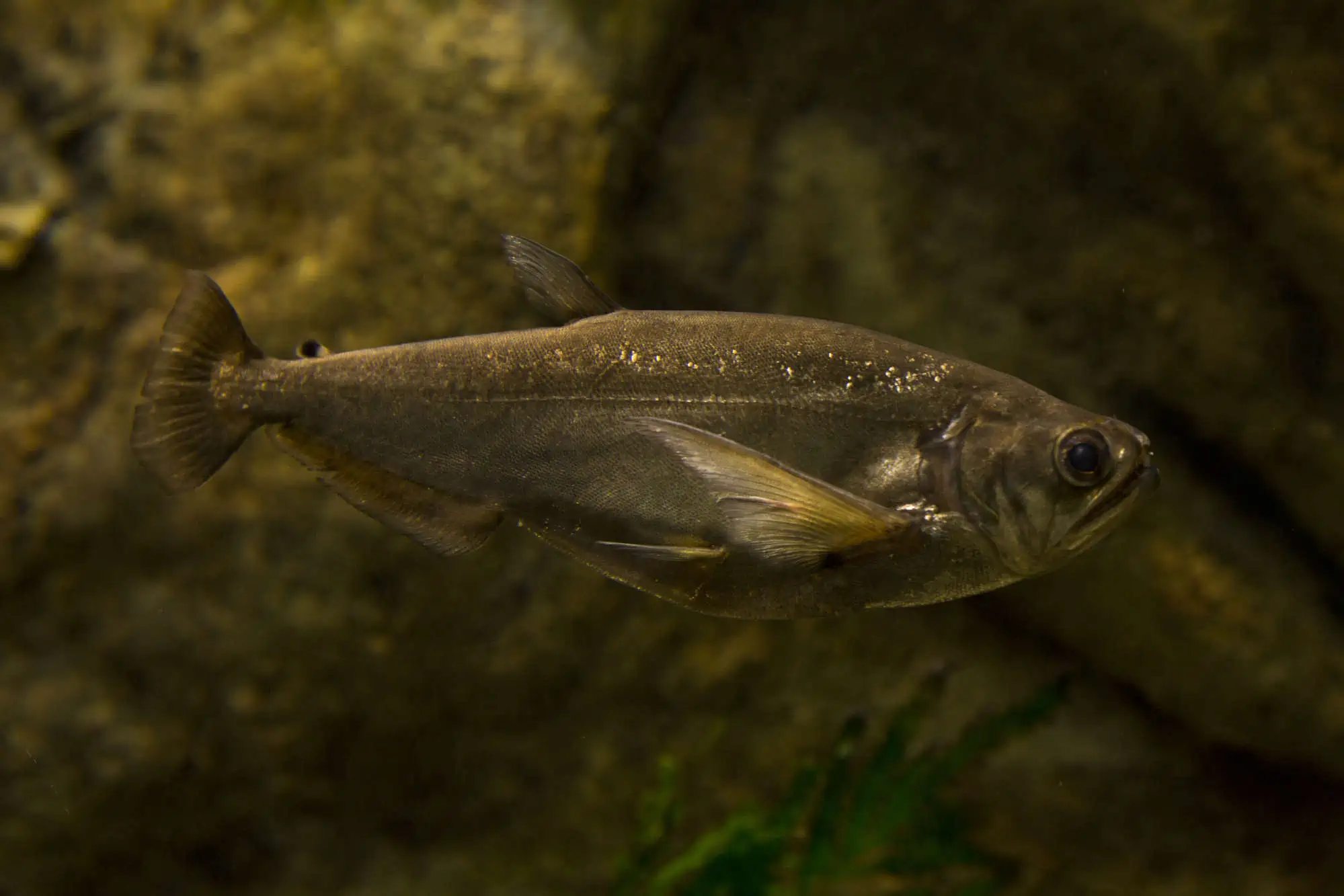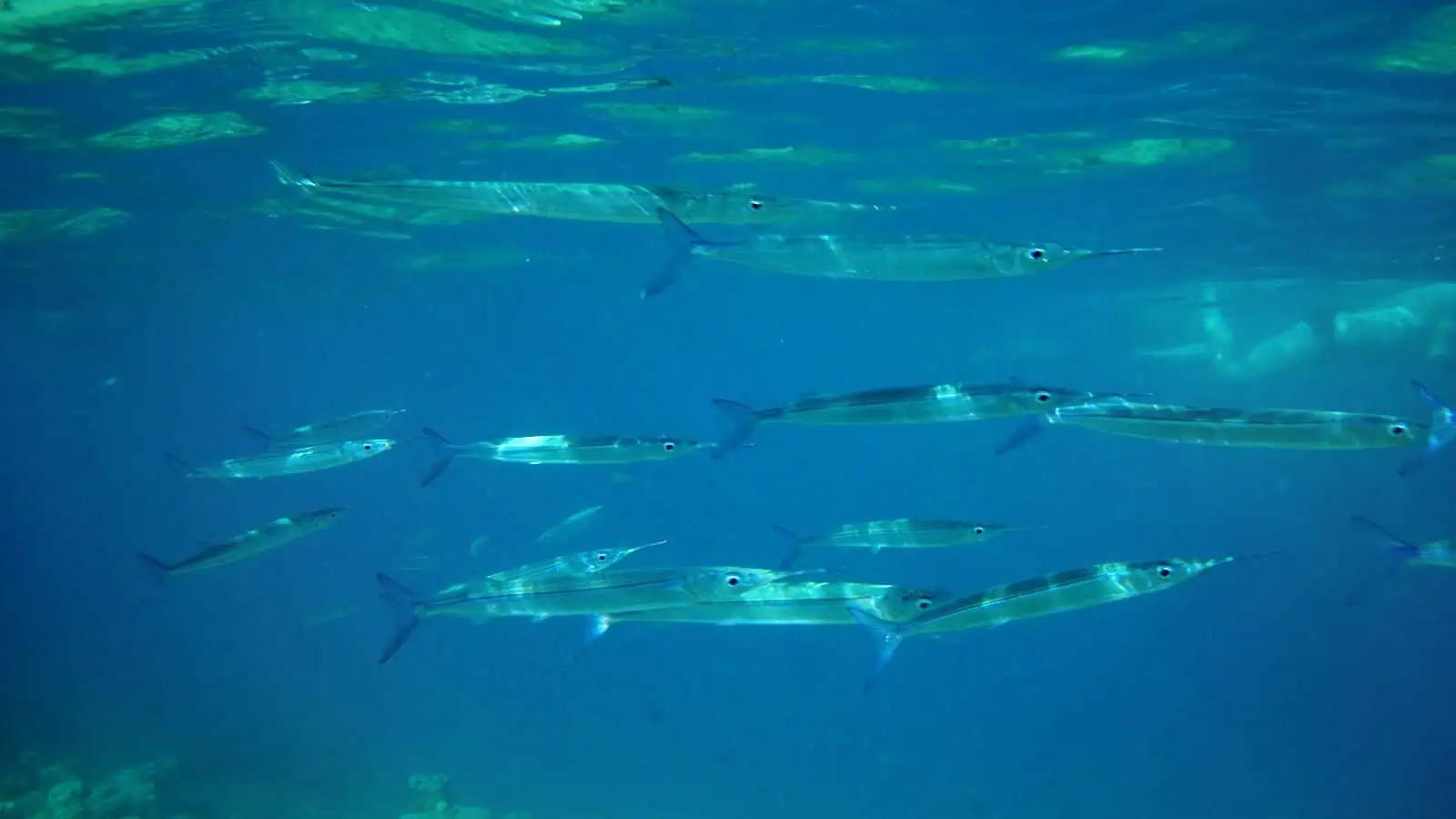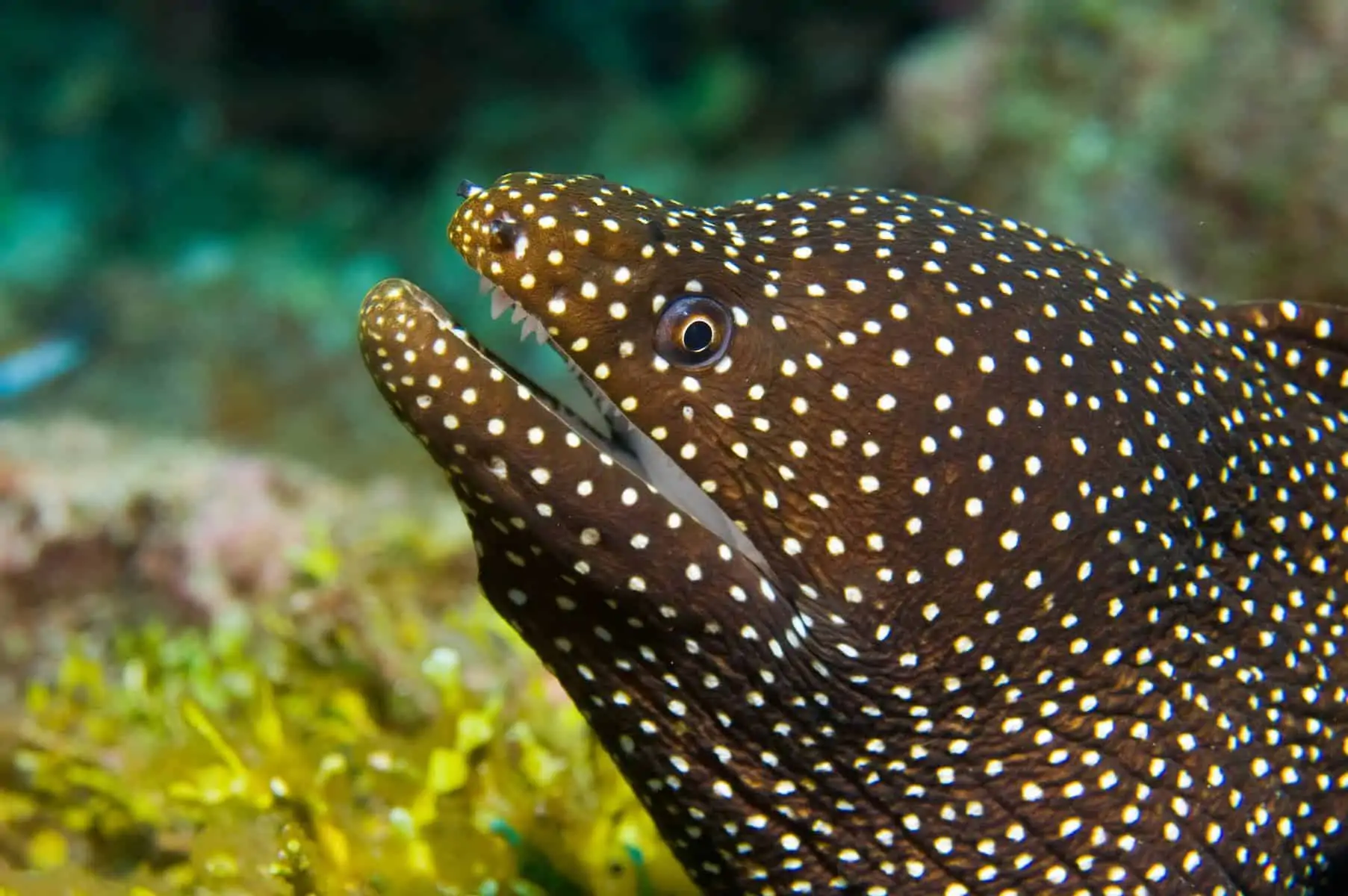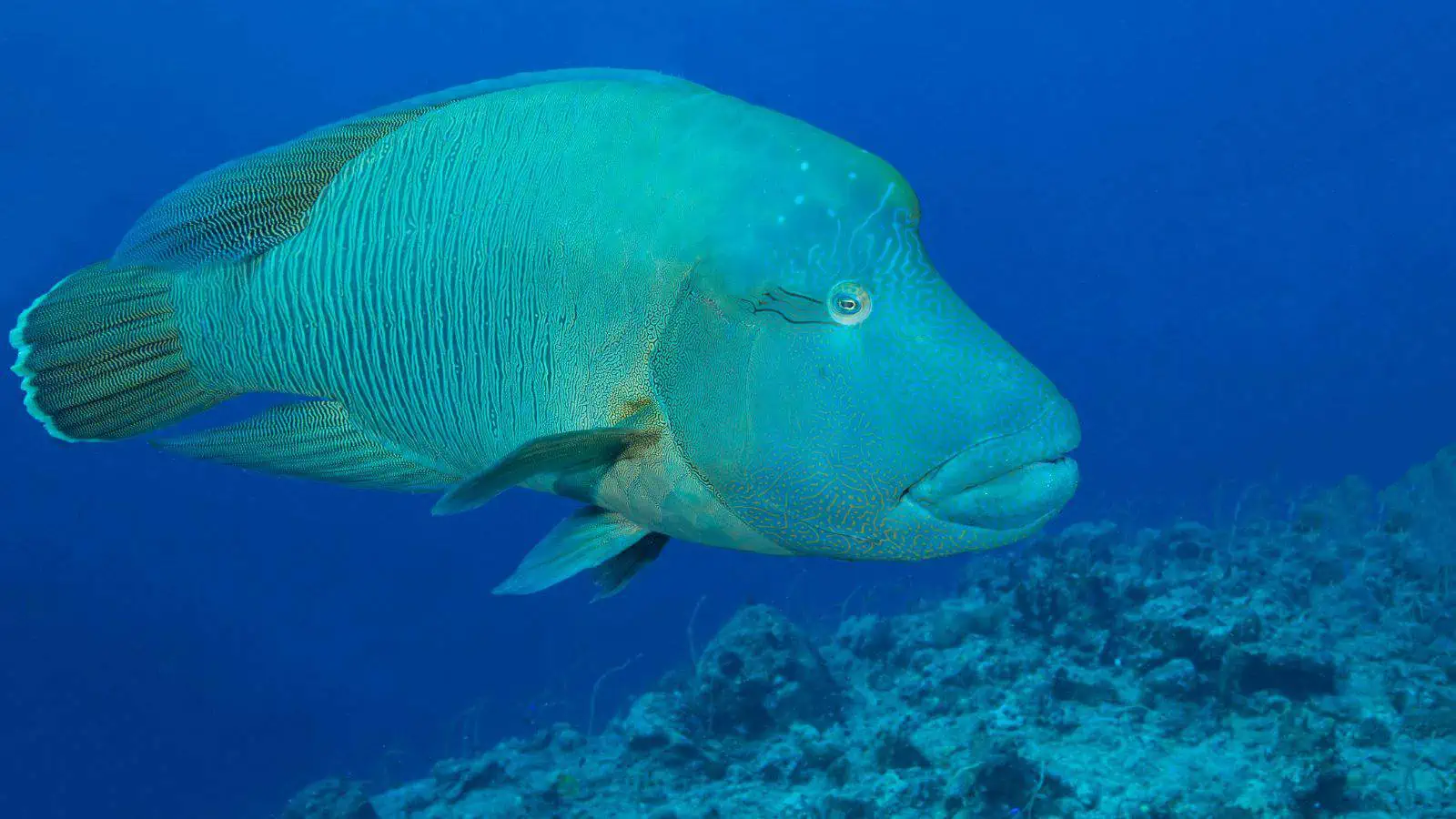Nature has evolved an incredible diversity of tooth adaptations in fish, from anglerfish with bioluminescent lures to sharks with serrated teeth. Each fish species’ unique dentition enables the creature to thrive in its environment and suits a diverse range of feeding habits and behaviors.
In this guide, we introduce 19 amazing fish species with terrifying teeth. You might want to look twice before you dive in!
Fish With Terrifying Teeth
You won’t find most of these fish for sale at your local aquarium store, with a few exceptions since many are ocean-dwellers or game fish. Nonetheless, all these critters have truly terrifying teeth and deserve their place on our list.
Great Barracuda

- Scientific name: Sphyraena barracuda
- Size: Can grow up to 6 feet (1.8 meters) in length
- Origin: Found in tropical and subtropical oceans around the world
The Great Barracuda is an opportunistic hunter and aggressive predator known for its fearsome appearance and terrifying teeth, which it uses to tear apart its prey.
These spectacular deep-water swimmers can reach speeds of up to 35 mph (56 km/h) when chasing down their prey, making them a challenge for deep-sea game fishermen.
Piranha

- Scientific name: Serrasalmus
- Size: From 6 to 12 inches (15 to 30 cm) in length
- Origin: Found in South American rivers, especially the Amazon basin
Piranhas have sharp teeth and powerful jaws, which have earned them a reputation as fearsome man-eating predators. However, that’s a tad unfair to these beautiful fish since they feed mainly on fish and carrion or sometimes attack larger, water-bound, injured animals.
Sheepshead Fish

- Scientific name: Archosargus probatocephalus
- Size: Up to 30 inches (76 cm) in length
- Origin: Native to the western Atlantic Ocean, ranging from the Northeastern United States to Brazil
The Sheepshead fish has remarkable dentition that closely resembles human teeth, with molars and incisors that the fish uses to crush its favorite prey of crustaceans, mollusks, and small crabs.
Tigerfish

- Scientific name: Hydrocynus vittatus
- Size: Up to 3 feet (1 meter) in length
- Origin: Found in various African rivers, including the Congo and Nile basins
The Tigerfish is a versatile and formidable predator with razor-sharp teeth. These fish are powerful swimmers that can leap out of the water to snatch small birds and flying insects right out of the air!
Vampire Fish (Payara)

- Scientific name: Hydrolycus scomberoides
- Size: Up to 4 feet (1.2 meters) in length
- Origin: Native to South America, commonly found in the Orinoco and Amazon basins
The Vampire fish gets its name from its long, fang-like teeth that can grow to an incredible 6 inches (15 cm) long! This fearsome fish impales its prey, including other fish, on its lethal fangs and is prized by anglers as a challenging gamefish.
Wels Catfish

- Scientific name: Silurus glanis
- Size: One of the largest freshwater fish in Europe, it can grow up to 13 feet (4 meters) in length
- Origin: Found in various European rivers and lakes
Wels catfish have rows of small, backward-pointing teeth that the creature uses to grasp onto its slippery fish prey. These are opportunistic predators that eat a wide variety of food, including other fish and even birds.
Sabertooth Blenny

- Scientific name: Aspidontus taeniatus
- Size: Up to 2.5 inches (6.5 cm) in length
- Origin: Found in the Indo-Pacific region, particularly around coral reefs
This tiny fish gets its name from the two large, protruding canine-like teeth in the front of its mouth, which it uses for defense against other fish that might dare to encroach on its territory. However, despite its intimidating appearance, the Sabretooth blenny feeds primarily on small crustaceans and algae.
Needlefish

- Scientific name: Belonidae family
- Size: Varies by species; some can grow up to 3 feet (1 meter) in length
- Origin: Found in both saltwater and freshwater habitats worldwide, depending on the species
Needlefish have long, slender bodies and sharp, needle-like teeth. These fish are excellent jumpers and can use their sharp, beak-like jaws to snatch insects and small fish from the water’s surface. In fact, some species of needlefish are known for leaping out of the water at high speeds, presenting an alarming danger to unwary boaters and anglers.
Moray Eel

- Scientific name: Muraenidae family
- Size: Varies by species; some can reach lengths of up to 13 feet (4 meters)
- Origin: Found in tropical and subtropical seas around the world
Moray eels have a unique set of pharyngeal jaws located in their throat as well as sharp teeth and a strong bite, which they use to snatch and immobilize their prey. When the eel captures prey with its front jaws, the animal’s secondary jaws help to drag the unfortunate prey further into the creature’s throat for consumption.
Dragonfish

- Scientific name: Stomiidae family
- Size: Ranges from a few inches to about a foot in length, depending on the species
- Origin: Found in deep ocean waters worldwide
The remarkable Dragonfish is bioluminescent, meaning the fish can produce their own light using special light-emitting organs called photophores. The fish use their light-producing abilities to attract prey and their incredibly sharp, fang-like teeth to capture and subdue their victim in the darkness of the deep sea.
Humphead Wrasse

- Scientific name: Cheilinus undulatus
- Size: Can grow up to 7.5 feet (2.3 meters) in length and weigh over 400 pounds (180 kg)
- Origin: Found in coral reefs of the Indo-Pacific region
The Humphead Wrasse is also known as the Napoleon Wrasse because of the prominent hump on its forehead. The fish has thick, powerful jaws with large, canine-like teeth that it uses to crush hard-shelled prey like crustaceans and mollusks, which form much of its prey.
The Humphead Wrasse plays an essential role in reef ecosystems by regulating reef-damaging species like crown-of-thorns starfish populations.
Tiger Shark

- Scientific name: Galeocerdo cuvier
- Size: Adults can reach lengths of up to 18 feet (5.5 meters)
- Origin: Found in warm ocean waters worldwide
Tiger sharks are so-named for the tiger-like stripes found on juvenile sharks, which fade as the animal matures.
These terrifying predators have unique teeth with serrated edges, which help them slice through a wide range of prey, including fish, seals, birds, and even sea turtles. Tiger sharks are known for their voracious appetites and are often referred to as “garbage eaters” because of their habit of consuming almost anything.
Anglerfish

- Scientific name: Lophiiformes order
- Size: Varies significantly by species, from a few inches to over 3 feet (1 meter) in length
- Origin: Found in deep ocean waters around the world
Anglerfish are famous for their bioluminescent lure that hangs in front of the creature’s mouth like a fishing rod and is used to attract smaller fish and crustaceans. When the prey gets close, the anglerfish snaps its sharp teeth shut to capture it.
Interestingly, male anglerfish are much smaller and attach themselves to females, acting as permanent parasites. Gross!
Atlantic Wolffish

- Scientific name: Anarhichas lupus
- Size: Can grow up to 5 feet (1.5 meters) in length
- Origin: Found in the cold waters of the North Atlantic Ocean
The Atlantic Wolffish has powerful jaws packed with large, canine-like teeth to crush the shells of the crustaceans, mollusks, and echinoderms that form most of the creature’s diet.
Atlantic Wolffish are known for their fierce territorial behavior and unique courtship ritual where the male fish “sings” to attract potential mates.
Goliath Tigerfish

- Scientific name: Hydrocynus goliath
- Size: One of the largest African freshwater fish, it can reach lengths of over 5 feet (1.5 meters)
- Origin: Found in the Congo River basin and Lake Tanganyika in Africa
The Goliath Tigerfish is a powerful predator with a mouth packed with razor-sharp teeth that the creature uses to catch and consume its large fish prey. These fish are renowned for their aggressive behavior and incredible speed that they use to chase down fast-swimming prey.
Goliath Tigerfish are highly sought after by anglers seeking the challenge of landing feisty larger fish, but the fish’s populations are declining due to overfishing and habitat destruction.
Greenland Shark

- Scientific name: (Somniosus microcephalus)
- Size: One of the largest shark species, it can grow up to 24 feet (7.3 meters) in length
- Origin: Found in the cold waters of the North Atlantic and Arctic Oceans
The Greenland shark has a mouth packed with small, needle-like teeth that it uses to catch and eat a variety of large prey, including fish, seals, and even other sharks.
These sharks are one of the longest-living vertebrates on the planet, with some individuals thought to have survived for over 400 years. Their slow metabolism contributes to the shark’s longevity but has the downside of making them sluggish and slow-moving.
Pufferfish

- Scientific name: (Tetraodontidae family)
- Size: Varies by species, ranging from a few inches to over 2 feet (60 cm) in length
- Origin: Found in tropical and subtropical waters worldwide
Despite their small size, many of the 120 known pufferfish species have powerful beak-like teeth that they use to crack open and eat hard-shelled prey like crustaceans and mollusks.
Pufferfish are slow swimmers, which makes them vulnerable to predators, so the fish have developed a unique defense mechanism. The puffer can inflate its body with water or air to deter predators and also contains potent toxins in its organs, making the fish highly poisonous to potential predators.
Puffers are considered a delicacy in some parts of the world. However, if the fish is not prepared correctly, the toxins it contains can kill unwary diners!
Green Sawfish

- Scientific name: (Pristis zijsron)
- Size: Can grow up to 23 feet (7 meters) in length
- Origin: Found in tropical and subtropical coastal waters
The Green Sawfish takes its name from the long, saw-like rostrum on its snout, which is studded with razor-sharp teeth. The fish uses its unique “saw” to slash through schools of fish or stir up the seabed to dislodge its prey.
Unfortunately, Green Sawfish populations have drastically declined in recent years due to habitat destruction and overfishing, making these awesome fish with teeth critically endangered.
Sarcastic Fringehead

- Scientific name: (Neoclinus blanchardi)
- Size: Grows up to 6 inches (15 cm) in length
- Origin: Found along the Pacific coast of North America, from California to Baja
The weirdly-named Sarcastic Fringehead has a wide mouth full of sharp teeth, which this unusual fish uses aggressively to intimidate territory rivals in a unique ritual known as ”mouth wrestling.”
Final Thoughts
Did you enjoy our article on fascinating fish species with frightening teeth? If you loved it, please hit the share button before you go!
Fish with teeth are typically predatory carnivores, although a few exceptions exist. However, what you’ve seen in this article might make you think twice about dipping a toe in the water in certain parts of the world!
If you keep a pet fish with frightening teeth, we’d love to hear about it! Tell us in the comments box below.


